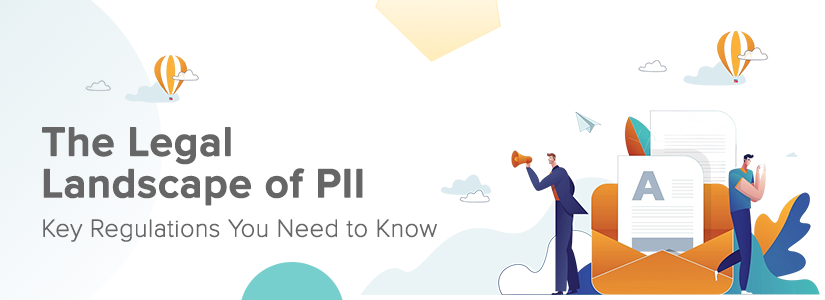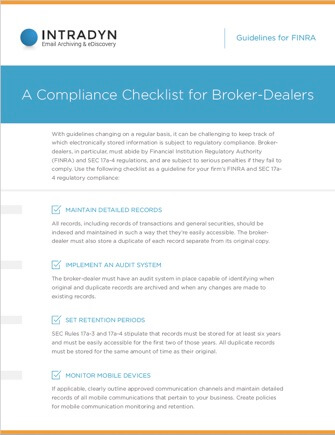The Legal Landscape of PII: Key Regulations You Need to Know

In an age where personal data flows freely across apps, devices, and digital platforms, protecting privacy has never been more urgent or complex. Businesses of all sizes collect and process vast amounts of personal information daily. But what keeps that data from being misused, exposed, or sold without consent? The answer lies in laws designed specifically to protect Personally Identifiable Information (PII).
But knowing what PII is only scratches the surface.
Here’s a quick overview of what will be covered in this blog:
- The role of data privacy laws in protecting PII and ensuring accountability
- How regulations classify PII: direct vs. indirect, sensitive vs. non-sensitive
- Key global and U.S. privacy laws (GDPR, CCPA, HIPAA) and their core requirements
- Common compliance practices such as consent, minimization, and breach notification
- Risks of non-compliance, including legal penalties and reputational harm
- How laws define and treat different types of PII based on risk and classification
The Role of Regulations in Protecting PII
Data privacy regulations exist to create structure in a digital environment that could otherwise operate without boundaries. They aren’t just about preventing cyberattacks, they’re about building trust. Regulations ensure that individuals have rights over their personal information and that organizations are held accountable for how they use it.
From large healthcare providers to small e-commerce shops, every organization that collects personally identifiable information (PII) has legal responsibilities. These regulations govern the collection, processing, storage, access, and deletion of PII. Furthermore, they establish individuals’ rights to know what information is held about them, and to request its correction or erasure.
Regulations serve three main purposes:
- Protecting individuals from harm (such as identity theft, discrimination, or surveillance)
- Setting standards for responsible data handling
- Creating consequences for non-compliance
Understanding the laws that regulate PII is crucial for businesses aiming to avoid penalties, earn customer trust, and operate responsibly in today’s data-driven landscape.
To grasp these laws, it’s important to understand what qualifies as PII. Legal frameworks don’t treat all personal information the same. Making proper classifications is essential for compliance and risk management.
- Direct identifiers include data such as Social Security numbers or passport details, which can independently identify an individual.
- Indirect identifiers such as ZIP codes or job titles only become personally revealing when combined with other pieces of information.
What’s more, many laws—such as GDPR and HIPAA—go further by distinguishing between Sensitive and Non-Sensitive PII. Sensitive PII, like health records or biometric data, carries a higher risk if exposed and is therefore subject to stricter legal requirements. Non-sensitive PII is usually less harmful if exposed on its own. Misclassifying or mishandling these categories can lead to regulatory breaches, reputational damage, and legal consequences. This refined view of data classification helps shape how regulations are written and enforced.
Major Data Privacy Laws (and What They Require)
Several landmark privacy laws have shaped today’s compliance landscape. While each law targets specific regions or sectors, they share a common goal: to protect personal information and give individuals control over their data.
1. GDPR (General Data Protection Regulation) – European Union
The GDPR is widely regarded as the most comprehensive data protection law in the world. It applies to any business, regardless of location, that collects or processes the personal data of EU residents.
Key GDPR requirements:
- Lawful basis for data processing
- Clear, informed consent
- Data minimization and purpose limitation
- Right to access, correct, and delete personal data
- Data breach notification within 72 hours
2. CCPA (California Consumer Privacy Act) – United States, California
The CCPA grants California residents more control over their personal data. While not as expansive as the GDPR, it marked a major turning point for U.S. privacy law. It introduced a new era of transparency and accountability for businesses handling consumer information. What’s more, CCPA also paved the way for similar legislation in other U.S. states.
Key CCPA rights:
- Know what personal data is collected
- Request deletion of personal data
- Opt out of the sale of their data
- Non-discrimination for exercising privacy rights
3. HIPAA (Health Insurance Portability and Accountability Act) – United States
HIPAA governs how healthcare providers, insurers, and their partners handle protected health information (PHI), a form of sensitive PII. It sets national standards for privacy, security, and breach notification to protect patient data. Failure to comply with these regulations can lead to significant financial penalties and reputational harm.
Key HIPAA requirements:
- Safeguards for storing and transmitting health data
- Limited access to PHI based on job function
- Breach notification and incident response
Why Legal Compliance Is Essential
Non-compliance with data privacy regulations can lead to serious and lasting consequences, far beyond a minor penalty.
- Financial penalties: The GDPR allows regulators to impose fines of up to €20 million or 4% of a company’s worldwide annual revenue. Under the CCPA, businesses may face fines of $2,500 for each unintentional violation and up to $7,500 for willful or intentional violations.
- Loss of business: Many contracts, especially in Business-to-Business (B2B) or international deals, now require proof of compliance with major regulations.
- Litigation risk: Non-compliance can result in lawsuits from affected individuals or class actions, especially if sensitive PII was exposed.
Legal compliance goes beyond meeting regulatory requirements. It plays a vital role in protecting your organization’s data, reputation, and long-term operations. Beyond that, it’s the key to building customer trust and maintaining strong business relationships.
What These Laws Typically Require
Despite regional and sectoral differences, most data privacy laws have core themes in common. Here’s what they typically require from organizations handling PII:
1. Informed Consent
Individuals must be told in clear, plain language what data is being collected, how it will be used, and whether it will be shared or sold. Most laws require consent to be:
- Freely given
- Specific
- Informed
- Revocable
This ensures individuals have real control over their personal information and can make informed decisions about how their data is handled.
2. Right to Access and Erasure
Consumers have the right to:
- Access their own personal data
- Request corrections to inaccurate information
- Request that their data be deleted (“right to be forgotten”)
These rights empower individuals to take charge of their digital privacy and hold organizations accountable for how their data is managed.
3. Data Minimization
Organizations are required to collect only the data they need for a specific, lawful purpose. Collecting data on a precautionary basis can lead to non-compliance and unnecessary risk. Limiting data collection supports compliance and reduces the risk of exposure in a breach. In turn, this strengthens trust with customers who are concerned about the amount of their personal information being collected and stored.
4. Security Safeguards
Laws mandate that organizations implement reasonable technical and organizational measures to protect PII. This includes encryption, access control, employee training, and breach notification procedures. These safeguards play a critical role in preventing unauthorized access, minimizing the risk of data breaches, and enabling prompt incident response when needed.
5. Data Subject Rights
Laws, including GDPR, give individuals rights over their data, including the right to:
- Object to processing
- Restrict use
- Port their data to another provider
These requirements not only inform your compliance strategy, but they also strengthen overall data protection efforts and customer trust.
How Privacy Laws Define PII
Understanding what counts as PII under the law is foundational to compliance. Most privacy regulations distinguish between different types of identifiers. As explained earlier, PII can be classified as direct or indirect, as well as sensitive or non-sensitive.
Here’s how these laws typically treat PII:
| Law | PII Definition | Special Protection for Sensitive Data? |
| GDPR | Any information relating to an identified or identifiable natural person | Yes, includes racial/ethnic data, health, biometrics, political views, etc. |
| CCPA | Information that identifies, relates to, describes, or could reasonably be linked with a consumer | Yes, for specific categories including geolocation, biometric, and health data |
| HIPPA | Protected Health Information (PHI): includes medical history, treatment, and payment info | Yes, mandates specific physical, administrative, and technical safeguards |
Sensitive data such as Social Security numbers, health records, and financial account details typically require the highest level of protection. Even indirect identifiers, such as ZIP codes and birthdates, can become identifying when combined.
Connecting the Dots: Classification, Risk & Regulation
Understanding legal requirements is only one component of a comprehensive compliance strategy. To effectively protect personally identifiable information (PII) and comply with data privacy laws, organizations must take a strategic approach that includes classifying the types of PII they collect, assessing the level of risk each type poses, and implementing appropriate safeguards.
Accurate classification is essential, as different types of PII carry varying levels of sensitivity and risk. Businesses can better understand which information demands higher security measures by identifying PII categories and tailoring security measures to ensure appropriate protection. This classification process forms the foundation for a risk-based approach to data protection.
Once classified, organizations must assess the risk associated with each type of data. This involves evaluating how the data is used, who has access, where it’s stored, and the potential impact if it were compromised. Based on this assessment, security measures can be calibrated to the specific risk level.
Laws depend on your ability to:
- Identify sensitive vs. non-sensitive PII
- Assign risk levels
- Implement tiered security based on classification
Failing to classify data properly can result in either under-protecting sensitive information or over-investing in low-risk areas. Achieving the right balance through effective classification and risk assessment is essential not only for regulatory compliance but also for maintaining trust with customers and safeguarding your organization’s reputation.
How Intradyn Helps Organizations Stay Compliant
Intradyn’s archiving solutions are designed with regulatory compliance in mind. By securely storing, encrypting, and managing business communications—especially emails containing sensitive PII—Intradyn helps your organization meet industry-specific regulations. Intradyn also offers archiving for text messages, WhatsApp messages, and social media platforms, ensuring comprehensive coverage of all critical communication channels. Whether you’re navigating GDPR, HIPAA, or CCPA, Intradyn gives you the tools to manage compliance and build trust without disrupting your operations.
Conclusion
As global data privacy laws continue to evolve, organizations must understand not just what PII is, but also how laws define and protect it. From consent requirements to breach notification rules, regulatory compliance is both a legal obligation and a strategic asset.
But compliance starts with clarity. By knowing what kinds of data you collect, classifying that data properly, and applying protections accordingly, you not only avoid fines, you foster trust, improve security, and position your organization for long-term success.
For more insights into protecting personal data:
Key Takeaways
- PII laws exist to protect individuals’ privacy rights and hold organizations accountable for how they collect, use, and store personal information.
- Not all PII is equal—regulations classify data into direct vs. indirect and sensitive vs. non-sensitive, each requiring different levels of protection.
- Major data privacy laws like GDPR, CCPA, and HIPAA set clear requirements around consent, access, data minimization, security, and breach response.
- Non-compliance carries serious consequences, including financial penalties, litigation, and reputational damage.
- Common compliance practices include informed consent, right to erasure, data minimization, and robust security safeguards.
- Proper data classification and risk assessment are essential for aligning protections with regulatory requirements and avoiding both under- and over-investment.
- Effective data governance starts with clarity. Knowing what PII you collect, how it’s classified, and applying the right protections is key to compliance and building trust.

